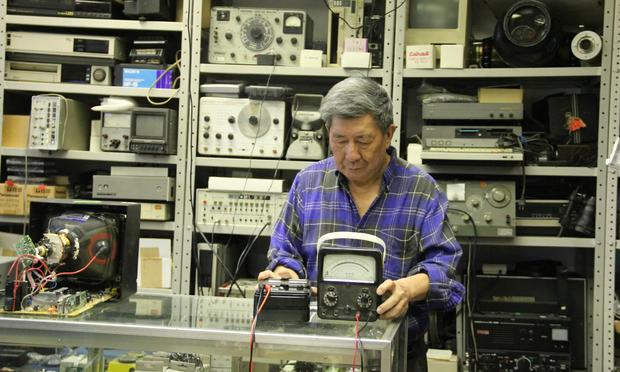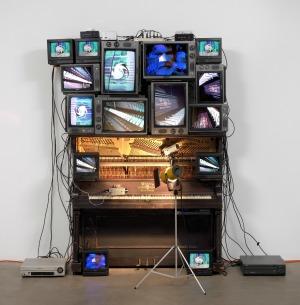Electronic Sculptures Need the Human Touch
 CT Lui in his shop, CTL Electronics
(Sruthi Pinnamaneni/WNYC)
CT Lui in his shop, CTL Electronics
(Sruthi Pinnamaneni/WNYC)
Nam Jun Paik was one of the first artists to engage seriously
with electronic technology as both a subject and a creative medium, and
he’s considered the father of new media art. Born in Seoul in 1932,
Paik studied electronic music in Germany and began developing new forms
of video art after he moved to the US. The Asia Society in New York is
featuring a major retrospective
of his work, including a cello made out of little televisions, a family
— mama, papa, and baby — of robots, and a player piano stacked with
video monitors that display a feed from surveillance cameras placed in
the gallery.
Paik was making these media sculptures in the 1960s and 70s, when video recording and cathode ray monitors were new. But for new media artists then and even now, it’s been difficult for artists to imagine that the latest technology would become obsolete so quickly. The parts become scarce, and the expertise to repair them even scarcer.
Right now, the person keeping Paik’s work alive and running is Chi-Tien (he goes by CT) Lui, the proprietor of CTL Electronics. Lui is an old-school TV and video repair man, but he’s more than that — he was a collaborator with Paik in helping him figure out how to retool monitors into objects like musical instruments and a wearable bra.
At the start, Paik “brought a camera to my place,” Lui recalls — one of the early Sony Portapak videocameras. “The picture looked horrible, so I did some adjustments. Ever since then he was in love.” The bromance lasted for decades, and Paik brought many of the artists in his circle to meet Lui. “Before he died, for a long time he would come visit me every weekend, bring a bottle of soda or something.”
For art curators and conservators, Lui’s skills and his relationship with artists are a desperately limited resource. He fixed Nam Jun Paik’s player piano sculpture for Glenn Wharton, who was then a conservator for the Museum of Modern Art. (You can see Wharton talk about the work here.) “The new generation of technical people may not know how to repair an old television set,” Wharton says. “We are racing against the clock. We’re trying to map out scenarios, buy technology, and we’re trying to move very fast on that, because one day the equipment may be there on the shelf and the next day it’s gone.” Programs in art conservation are only beginning to offer training in electronics, and curators now shoot videos of Lui at work to try to preserve his methods.
Ironically, Lui himself didn’t watch television until he was almost 30, on board a ship for the US. Growing up in Taiwan, he explained, “There’s a lot of GI’s, military personnel — they didn’t know Taiwan has no TV. So every family brings their washing machine and their TV set. And they found out there’s no TV [broadcast]. So they all donated to our TV school. We learned [to fix] TV but we can’t watch a picture — we watched snow.”
Video: Conservator Glenn Wharton describes restoring Nam June Paik's "Untitled"
Paik was making these media sculptures in the 1960s and 70s, when video recording and cathode ray monitors were new. But for new media artists then and even now, it’s been difficult for artists to imagine that the latest technology would become obsolete so quickly. The parts become scarce, and the expertise to repair them even scarcer.
Right now, the person keeping Paik’s work alive and running is Chi-Tien (he goes by CT) Lui, the proprietor of CTL Electronics. Lui is an old-school TV and video repair man, but he’s more than that — he was a collaborator with Paik in helping him figure out how to retool monitors into objects like musical instruments and a wearable bra.
At the start, Paik “brought a camera to my place,” Lui recalls — one of the early Sony Portapak videocameras. “The picture looked horrible, so I did some adjustments. Ever since then he was in love.” The bromance lasted for decades, and Paik brought many of the artists in his circle to meet Lui. “Before he died, for a long time he would come visit me every weekend, bring a bottle of soda or something.”
For art curators and conservators, Lui’s skills and his relationship with artists are a desperately limited resource. He fixed Nam Jun Paik’s player piano sculpture for Glenn Wharton, who was then a conservator for the Museum of Modern Art. (You can see Wharton talk about the work here.) “The new generation of technical people may not know how to repair an old television set,” Wharton says. “We are racing against the clock. We’re trying to map out scenarios, buy technology, and we’re trying to move very fast on that, because one day the equipment may be there on the shelf and the next day it’s gone.” Programs in art conservation are only beginning to offer training in electronics, and curators now shoot videos of Lui at work to try to preserve his methods.
Ironically, Lui himself didn’t watch television until he was almost 30, on board a ship for the US. Growing up in Taiwan, he explained, “There’s a lot of GI’s, military personnel — they didn’t know Taiwan has no TV. So every family brings their washing machine and their TV set. And they found out there’s no TV [broadcast]. So they all donated to our TV school. We learned [to fix] TV but we can’t watch a picture — we watched snow.”
Video: Conservator Glenn Wharton describes restoring Nam June Paik's "Untitled"

No comments:
Post a Comment
Note: Only a member of this blog may post a comment.